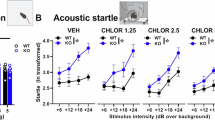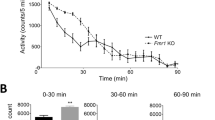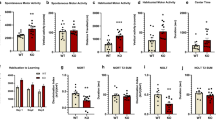Abstract
In fragile X syndrome (FXS), sensory hypersensitivity and impaired habituation is thought to result in attention overload and various behavioral abnormalities in reaction to the excessive and remanent salience of environment features that would normally be ignored. This phenomenon, termed sensory defensiveness, has been proposed as the potential cause of hyperactivity, hyperarousal, and negative reactions to changes in routine that are often deleterious for FXS patients. However, the lack of tools for manipulating sensory hypersensitivity has not allowed the experimental testing required to evaluate the relevance of this hypothesis. Recent work has shown that BMS-204352, a BKCa channel agonist, was efficient to reverse cortical hyperexcitability and related sensory hypersensitivity in the Fmr1-KO mouse model of FXS. In the present study, we report that exposing Fmr1-KO mice to novel or unfamiliar environments resulted in multiple behavioral perturbations, such as hyperactivity, impaired nest building and excessive grooming of the back. Reversing sensory hypersensitivity with the BKCa channel agonist BMS-204352 prevented these behavioral abnormalities in Fmr1-KO mice. These results are in support of the sensory defensiveness hypothesis, and confirm BKCa as a potentially relevant molecular target for the development of drug medication against FXS/ASD.
Similar content being viewed by others

Log in or create a free account to read this content
Gain free access to this article, as well as selected content from this journal and more on nature.com
or
References
Andrea S, Jacena LM, Patrick A, Rawi N, Tasleem C, John O et al (2013). Electrocortical changes associated with minocycline treatment in fragile X syndrome. J Psychopharmacol (Oxford, England) 27: 956–963.
Arnett MT, Herman DH, McGee AW (2014). Deficits in tactile learning in a mouse model of fragile X syndrome. PLoS ONE 9: e109116.
Baranek GT, Foster LG, Berkson G (1997). Tactile defensiveness and stereotyped behaviors. Am J Occup Ther 51: 91–95.
Berry-Kravis E, Sumis A, Hervey C, Nelson M, Porges SW, Weng N et al (2008). Open-label treatment trial of lithium to target the underlying defect in fragile X syndrome. J Dev Behav Pediatr 29: 293–302.
Castrén M, Pääkkönen A, Tarkka IM, Ryynänen M, Partanen J (2003). Augmentation of auditory N1 in children with fragile X syndrome. Brain Topogr 15: 165–171.
Chen L, Toth M (2001). Fragile X mice develop sensory hyperreactivity to auditory stimuli. Neuroscience 103: 1043–1050.
Contractor A, Klyachko VA, Portera-Cailliau C (2015). Altered neuronal and circuit excitability in fragile X syndrome. Neuron 87: 699–715.
Dailly E, Hascoët M, Colombel MC, Jolliet P, Bourin M (2002). Relationship between cerebral pharmacokinetics and anxiolytic activity of diazepam and its active metabolites after a single intra-peritoneal administration of diazepam in mice. Hum Psychopharmacol 17: 239–245.
Dansie LE, Phommahaxay K, Okusanya AG, Uwadia J, Huang M, Rotschafer SE et al (2013). Long-lasting effects of minocycline on behavior in young but not adult Fragile X mice. Neuroscience 246: 186–198.
de Diego-Otero Y, Romero-Zerbo Y, Bekay RE, Decara J, Sanchez L, Fonseca FR-D et al (2008). [alpha]-Tocopherol protects against oxidative stress in the fragile X knockout mouse: an experimental therapeutic approach for the Fmr1 deficiency. Neuropsychopharmacology 34: 1011–1026.
Deacon R (2012). Assessing burrowing, nest construction, and hoarding in mice. J Vis Exp: e2607.
Deacon RMJ (2006). Assessing nest building in mice. Nat Protoc 1: 1117–1119.
Deng PY, Klyachko VA (2016). Genetic upregulation of BK channel activity normalizes multiple synaptic and circuit defects in a mouse model of fragile X syndrome. J Physiol 594: 83–97.
Deng PY, Rotman Z, Blundon JA, Cho Y, Cui J, Cavalli V et al (2013). FMRP regulates neurotransmitter release and synaptic information transmission by modulating action potential duration via BK channels. Neuron 77: 696–711.
The Dutch-Belgian Fragile X Consortium, Bakker CE, Verheij C, Willemsen R, van der Helm R, Oerlemans F et al (1994). Fmr1 knockout mice: a model to study fragile X mental retardation. Cell 78: 23–33.
Ethridge LE, White SP, Mosconi MW, Wang J, Byerly MJ, Sweeney JA (2016). Reduced habituation of auditory evoked potentials indicate cortical hyper-excitability in fragile X syndrome. Transl Psychiatry 6: e787.
Frankland PW, Wang Y, Rosner B, Shimizu T, Balleine BW, Dykens EM et al (2004). Sensorimotor gating abnormalities in young males with fragile X syndrome and Fmr1-knockout mice. Mol Psychiatry 9: 417–425.
Gibson JR, Bartley AF, Hays SA, Huber KM (2008). Imbalance of neocortical excitation and inhibition and altered UP states reflect network hyperexcitability in the mouse model of fragile X syndrome. J Neurophysiol 100: 2615–2626.
Goncalves JT, Anstey JE, Golshani P, Portera-Cailliau C (2013). Circuit level defects in the developing neocortex of Fragile X mice. Nat Neurosci 16: 903–909.
Hagerman RJ (2006). Lessons from fragile X regarding neurobiology, autism, and neurodegeneration. J Dev Behav Pediatr 27: 63–74.
Hébert B, Pietropaolo S, Même S, Laudier B, Laugeray A, Doisne N et al (2014). Rescue of fragile X syndrome phenotypes in Fmr1 KO mice by a BKCa channel opener molecule. Orphanet J Rare Dis 9: 1–10.
Jensen BS (2002). BMS-204352: a potassium channel opener developed for the treatment of stroke. CNS Drug Rev 8: 353–360.
Jirkof P (2014). Burrowing and nest building behavior as indicators of well-being in mice. J Neurosci Methods 234: 139–146.
Kazdoba TM, Leach PT, Silverman JL, Crawley JN (2014). Modeling fragile X syndrome in the Fmr1 knockout mouse. Intractable Rare Dis Res 3: 118–133.
Kramvis I, Mansvelder H, Loos M, Meredith R (2013). Hyperactivity, perseveration and increased responding during attentional rule acquisition in the fragile X mouse model. Front Behav Neurosci 7: 172.
Krueger DD, Bear MF (2011). Toward fulfilling the promise of molecular medicine in fragile X syndrome. Annu Rev Med 62: 411–429.
Lovelace JW, Wen TH, Reinhard S, Hsu MS, Sidhu H, Ethell IM et al (2016). Matrix metalloproteinase-9 deletion rescues auditory evoked potential habituation deficit in a mouse model of Fragile X Syndrome. Neurobiol Dis 89: 126–135.
McNaughton CH, Moon J, Strawderman MS, Maclean KN, Evans J, Strupp BJ (2008). Evidence for social anxiety and impaired social cognition in a mouse model of fragile X syndrome. Behav Neurosci 122: 293–300.
Merenstein SA, Sobesky WE, Taylor AK, Riddle JE, Tran HX, Hagerman RJ (1996). Molecular-clinical correlations in males with an expanded FMR1 mutation. Am J Med Genet 64: 388–394.
Meshalkina DA, Kalueff AV (2016). Commentary: Ethological evaluation of the effects of social defeat stress in mice: beyond the social interaction ratio. Front Behav Neurosci 10: 155.
Michalon A, Sidorov M, Ballard Theresa M, Ozmen L, Spooren W, Wettstein Joseph G et al (2012). Chronic pharmacological mGlu5 inhibition corrects fragile X in adult mice. Neuron 74: 49–56.
Mientjes EJ, Nieuwenhuizen I, Kirkpatrick L, Zu T, Hoogeveen-Westerveld M, Severijnen L et al (2006). The generation of a conditional Fmr1 knock out mouse model to study Fmrp function in vivo. Neurobiol Dis 21: 549–555.
Miller LJ, McIntosh DN, McGrath J, Shyu V, Lampe M, Taylor AK et al (1999). Electrodermal responses to sensory stimuli in individuals with fragile X syndrome: a preliminary report. Am J Med Genet 83: 268–279.
Mineur YS, Sluyter F, Wit S, Oostra BA, Crusio WE (2002). Behavioral and neuroanatomical characterization of the Fmr1 knockout mouse. Hippocampus 12: 39–46.
Moon J, Beaudin AE, Verosky S, Driscoll LL, Weiskopf M, Levitsky DA et al (2006). Attentional dysfunction, impulsivity, and resistance to change in a mouse model of fragile X syndrome. Behav Neurosci 120: 1367–1379.
Moon J, Ota KT, Driscoll LL, Levitsky DA, Strupp BJ (2008). A mouse model of fragile X syndrome exhibits heightened arousal and/or emotion following errors or reversal of contingencies. Dev Psychobiol 50: 473–485.
Musumeci SA, Bosco P, Calabrese G, Bakker C, De Sarro GB, Elia M et al (2000). Audiogenic seizures susceptibility in transgenic mice with fragile X syndrome. Epilepsia 41: 19–23.
Myrick LK, Deng P-Y, Hashimoto H, Oh YM, Cho Y, Poidevin MJ et al (2015). Independent role for presynaptic FMRP revealed by an FMR1 missense mutation associated with intellectual disability and seizures. Proc Natl Acad Sci USA 112: 949–956.
Nielsen DM, Derber WJ, McClellan DA, Crnic LS (2002). Alterations in the auditory startle response in Fmr1 targeted mutant mouse models of fragile X syndrome. Brain Res 927: 8–17.
Oddi D, Subashi E, Middei S, Bellocchio L, Lemaire-Mayo V, Guzman M et al (2015). Early social enrichment rescues adult behavioral and brain abnormalities in a mouse model of fragile X syndrome. Neuropsychopharmacology 40: 1113–1122.
Olmos-Serrano JL, Corbin JG, Burns MP (2011). The GABA-A receptor agonist THIP ameliorates specific behavioral deficits in the mouse model of fragile X syndrome. Dev Neurosci 33: 395–403.
Paribello C, Tao L, Folino A, Berry-Kravis E, Tranfaglia M, Ethell IM et al (2010). Open-label add-on treatment trial of minocycline in fragile X syndrome. BMC Neurol 10: 91.
Peier AM, McIlwain KL, Kenneson A, Warren ST, Paylor R, Nelson DL (2000). Over)correction of FMR1 deficiency with YAC transgenics: behavioral and physical features. Hum Mol Genet 9: 1145–1159.
Perry W, Minassian A, Lopez B, Maron L, Lincoln A (2007). Sensorimotor gating deficits in adults with autism. Biol Psychiatry 61: 482–486.
Pietropaolo S, Guilleminot A, Martin B, D’Amato FR, Crusio WE (2011). Genetic-background modulation of core and variable autistic-like symptoms in Fmr1 knock-out mice. PLoS ONE 6: e17073.
Razali NM, Bee Wah Y (2011). Power comparisons of Shapiro-Wilk, Kolmogorov-Smirnov, Lilliefors and Anderson-Darlingtests. J Stat Model Analyt 2: 21–33.
Restivo L, Ferrari F, Passino E, Sgobio C, Bock J, Oostra BA et al (2005). Enriched environment promotes behavioral and morphological recovery in a mouse model for the fragile X syndrome. Proc Natl Acad Sci USA 102: 11557–11562.
Rotschafer S, Razak K (2013). Altered auditory processing in a mouse model of fragile X syndrome. Brain Res 1506: 12–24.
Schneider A, Leigh MJ, Adams P, Nanakul R, Chechi T, Olichney J et al (2013). Electrocortical changes associated with minocycline treatment in fragile X syndrome. J Psychopharmacol 27: 956–963.
Song C, Berridge KC, Kalueff AV (2016). 'Stressing' rodent self-grooming for neuroscience research. Nat Rev Neurosci 17: 591–591.
Spencer CM, Alekseyenko O, Hamilton SM, Thomas AM, Serysheva E, Yuva-Paylor LA et al (2011). Modifying behavioral phenotypes in Fmr1KO mice: genetic background differences reveal autistic-like responses. Autism Res 4: 40–56.
Symons FJ, Clark RD, Hatton DD, Skinner M, Bailey DB (2003). Self-injurious behavior in young boys with fragile X syndrome. Am J Med Genet A 118A: 115–121.
van Erp AMM, Kruk MR, Meelis W, Willekens-Bramer DC (1994). Effect of environmental stressors on time course, variability and form of self-grooming in the rat: handling, social contact, defeat, novelty, restraint and fur moistening. Behav Brain Res 65: 47–55.
Verkerk AJMH, Pieretti M, Sutcliffe JS, Fu Y-H, Kuhl DPA, Pizzuti A et al (1991). Identification of a gene (FMR-1) containing a CGG repeat coincident with a breakpoint cluster region exhibiting length variation in fragile X syndrome. Cell 65: 905–914.
Yuhas J, Cordeiro L, Tassone F, Ballinger E, Schneider A, Long JM et al (2011). Brief report: sensorimotor gating in idiopathic autism and autism associated with fragile X syndrome. J Autism Dev Disord 41: 248–253.
Zhang Y, Bonnan A, Bony G, Ferezou I, Pietropaolo S, Ginger M et al (2014). Dendritic channelopathies contribute to neocortical and sensory hyperexcitability in Fmr1(−/y) mice. Nat Neurosci 17: 1701–1709.
Acknowledgements
We thank Nora Abrous and Guillaume Lucas for feedback on the manuscript. This work was supported by funding from INSERM, CNRS, and Agence Nationale pour la Recherche (ANR). We thank the Animal Housing and Genotyping facilities, supported by funding from INSERM and LabEX BRAIN (ANR-10-LABX-43). MICM was supported by an international PhD fellowship (ANR-10-IDEX-03-02). The funders had no role in study design, data collection and analysis, decision to publish, or preparation of the manuscript.
Author contributions
XL conceived the project. MICM, MG, AF, and XL planned the research. MICM, FM, MCM, EA, CD, ES, GB, MG, and XL performed data acquisition. MICM, FM, EA, CD, SP, GB, AM, and XL analyzed the data. MICM and XL wrote the paper and all other authors provided feedback.
Author information
Authors and Affiliations
Corresponding author
Additional information
Supplementary Information accompanies the paper on the Neuropsychopharmacology website
Rights and permissions
About this article
Cite this article
Carreno-Munoz, M., Martins, F., Medrano, M. et al. Potential Involvement of Impaired BKCa Channel Function in Sensory Defensiveness and Some Behavioral Disturbances Induced by Unfamiliar Environment in a Mouse Model of Fragile X Syndrome. Neuropsychopharmacol. 43, 492–502 (2018). https://doi.org/10.1038/npp.2017.149
Received:
Revised:
Accepted:
Published:
Issue date:
DOI: https://doi.org/10.1038/npp.2017.149
This article is cited by
-
Altered trial-to-trial responses to reward outcomes in KCNMA1 knockout mice during probabilistic learning tasks
Behavioral and Brain Functions (2024)
-
Therapeutic efficacy of the BKCa channel opener chlorzoxazone in a mouse model of Fragile X syndrome
Neuropsychopharmacology (2024)
-
Endogenous noise of neocortical neurons correlates with atypical sensory response variability in the Fmr1−/y mouse model of autism
Nature Communications (2023)
-
Large-conductance calcium-activated potassium channel haploinsufficiency leads to sensory deficits in the visual system: a case report
Journal of Medical Case Reports (2022)
-
Detecting fine and elaborate movements with piezo sensors provides non-invasive access to overlooked behavioral components
Neuropsychopharmacology (2022)


